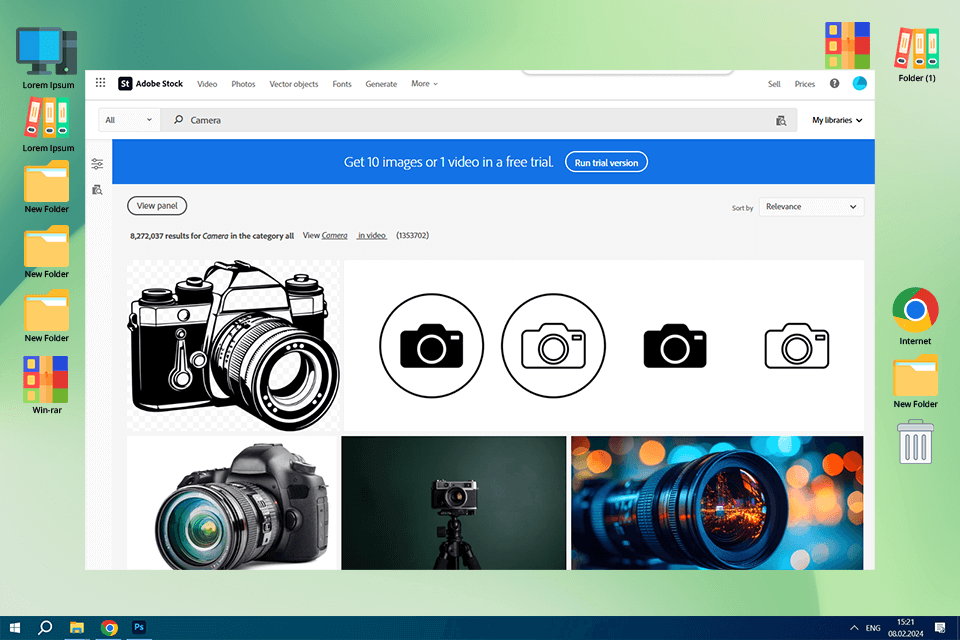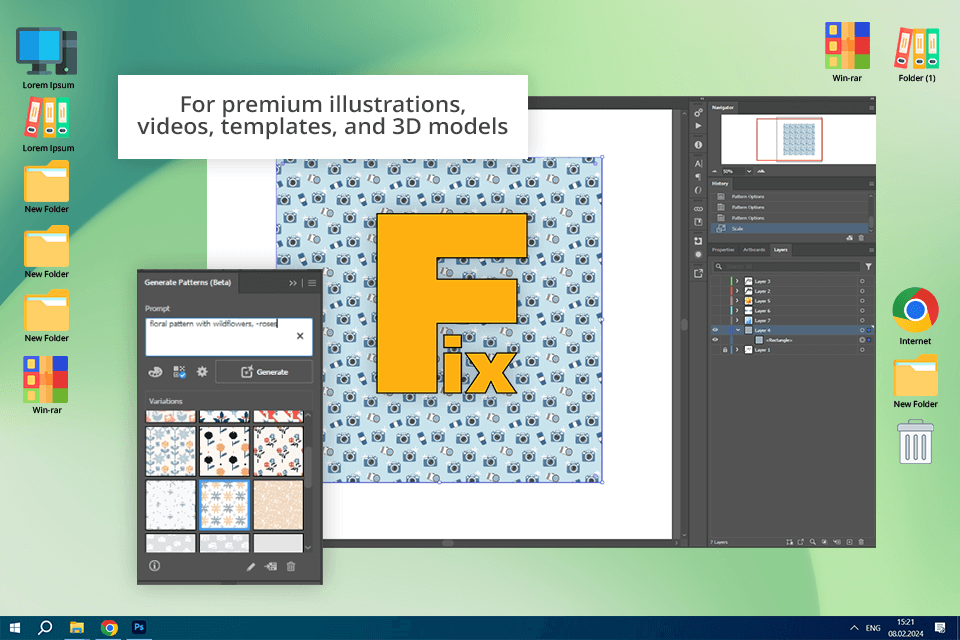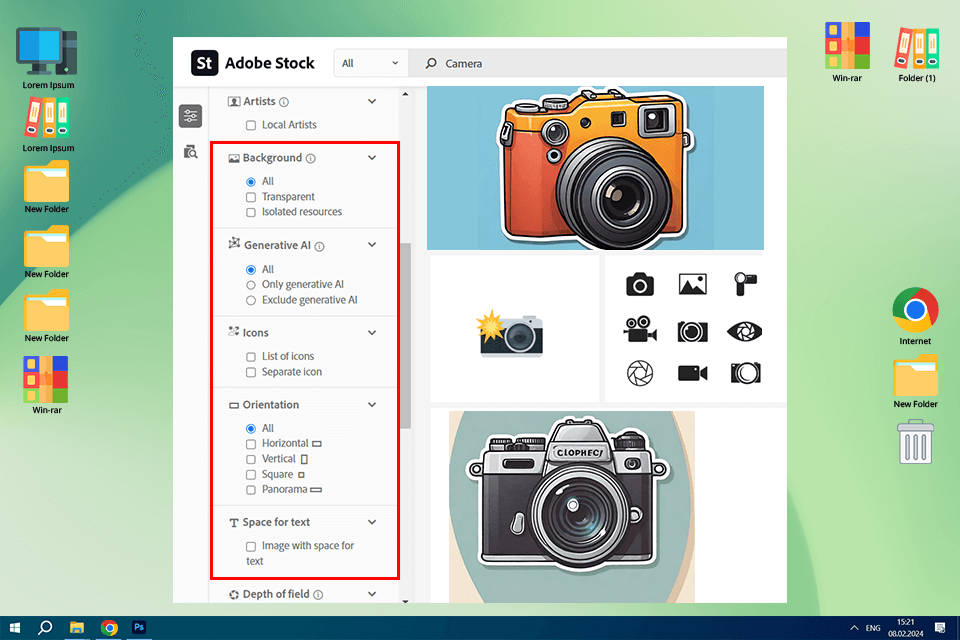When I was writing an article about the top locations for family photoshoots in New York City in our blog, I was in search of some eye-catching images of the city to go along with my own work. I headed to Adobe Stock, as the platform offers lots of stock images.
On the website, I saw that some materials were marked “Standard License” and “Extended License”. What is the difference? When should I choose each option? How can I make sure I don't misuse an image and run into legal problems?
Furthermore, Adobe Stock has just introduced some truly remarkable AI-based functionalities. Now, users can take advantage of Generative Edits and Generate Variations. I was eager to test their capabilities, but I didn’t fully understand how these new AI tools influenced licensing. Do I have to abide by new guidelines when using AI to edit stock photos?
I was intrigued and decided to compare the licenses myself. I spent hours examining Adobe Stock's licensing conditions. I did my best to discern the differences between the Standard and Extended options and figure out when to choose each license. The process got even more interesting, considering the addition of AI-based functionalities.

Adobe Stock is a great platform for beginners and professionals alike. It is a huge online library filled with millions of high-quality, royalty-free assets. Here, you can find lots of materials, including:
Photos: Lots of genres, including landscapes, lifestyle shots, images of animals, etc.
Vectors: Scalable graphics for logos and illustrations.
Illustrations: Unique artwork to make your projects special.
Templates: Ready-to-use layouts for brochures, flyers, social media posts, and more.
3D assets: For people interested in 3D design.
Videos: Stock footage to jazz up your video projects.
Motion graphics templates: Pre-designed animated graphics for video editing.
Audio tracks: Music and sound effects for different needs.
Technically minded creatives will definitely like that Adobe Stock is integrating Generative AI capabilities. Currently, you can use Generative Edits and Generate Variations. With such tools, you can not only use stock assets but also apply personalized touches to them. Generally, it is possible to customize and modify them in ways previously unimaginable. Just picture this:
✔️ You can now change or delete an image background even before licensing it. Thus, photo post-production becomes much faster.
✔️ It is possible to resize images to match various aspect ratios. Whether you need a square image for Instagram or a widescreen one for your website, Adobe Stock's AI can handle it. It will create new content that looks like it was always part of the original image.
✔️ You can create different versions of an image by adjusting its style and composition. If you're looking for a more artistic feel or a new framing, AI can help you produce unique variations that perfectly align with your vision.
Undeniably, AI features are a terrific upgrade. Still, they underscore the need to understand Adobe Stock license terms. Are there separate rules for AI-modified content? Can you use stock assets the way you did without AI processing? I needed clarity on these points.
Many people think that all stock image licenses are equal. However, this couldn't be further from the truth. Different projects need different licenses. So, when making something for personal use, commercial needs, or resale, it is paramount to choose the correct Adobe Stock license. Thus, you can spend your money wisely and avoid possible legal problems down the road.
To make sure I get the right Adobe Stock license, I use this simple list of questions. It helps me compare Adobe Stock Standard vs Extended License:
1. What will I use my assets for?
✔️ General business use (website, social media, presentations, ads, etc.) → Standard License
✔️ Marketing materials & packaging (up to 500,000 copies/views) → Standard License
✔️ Marketing materials & packaging (beyond 500,000 copies/views) → Extended License
✔️ Products for resale (T-shirts, mugs, posters, templates, etc.) → Extended License
❌ Editorial use only - Assets cannot be used for commercial needs (even with an Extended License) without explicit permission from the copyright owner.
2. How many copies/views will the asset have?
✔️ Less than 500,000 copies/views → Standard License
✔️ More than 500,000 copies/views → Extended License
3. Will I use this asset in products that I sell or distribute?
✔️ No, I need this asset solely for content creation, marketing, or internal use → Standard License
✔️ Yes, I want to sell merchandise featuring this asset (posters, mugs, T-shirts, etc.) → Extended License
❌ I plan to distribute the original, unmodified asset as a file → Not allowed under any license
4. Do I plan to use Adobe Stock for videos, 3D resources, or templates?
✔️ Yes, and I need more than 500,000 copies/views → Enhanced License (for videos, templates, 3D assets, Premium Collection)
✔️ Yes, and I plan to resell the asset within a template or product → Extended License (if applicable)
5. Am I using Adobe Stock for audio?
✔️ Yes, I’ll use it for social media, websites, corporate presentations, or digital ads → Audio Standard License
✔️ Yes, I’ll use it for TV, radio, streaming platforms, video games, or theatrical releases → Audio Extended License
❌ Remixing, distributing as a standalone file, or using for branding → Not allowed
6. Is it possible to share or transfer my license to someone else?
✔️ It is allowed to share the asset (unmodified) with employees or contractors under contract
✔️ I can transfer the license to a single client or employer
❌ I cannot transfer the license to multiple clients (must purchase a separate license for each)

The Standard License can be treated as a basic Adobe Stock license. It's meant to meet many common creative needs. When choosing it, you get extensive permissions for everyday stock photography site use. Here's a breakdown of what you can do with it:
✔️ What you CAN do with a Standard License:
Broad media use. Use the assets in any medium, such as print materials, digital presentations, broadcast media, websites, and social media platforms.
Marketing & advertising. Take advantage of assets for marketing and advertising purposes, e.g., in email campaigns, mobile advertisements, and broadcast or online programs (subject to viewer limitations – see details below)
Print reproductions. Create up to 500,000 copies of the asset in any medium, such as product packaging, print marketing materials, digital documents, and software.
Digital program views. Add assets in broadcasts or online programs as long as the expected audience is under 500,000 viewers.
Website & social media. Post assets on websites or social media platforms with unlimited views.
Limited product inclusion. Include assets in products like textbooks, as long as the asset isn't the main selling point and the number of copies is less than 500,000.
Collaboration & client work. Share the original asset with your team and contractors who have signed confidentiality agreements. You can also transfer the license to one client or employer.
Generative AI features. Use Generative Edits and Generate Variations on Standard Licensed assets.
❌ What you CAN NOT do with a Standard License:
Resell stand-alone files. You cannot distribute the original asset as an independent file. This restriction applies to all licenses on Adobe Stock or Shutterstock.
Merchandise for resale. It is prohibited to use assets in products, templates, or items intended for resale if the asset is the main selling point (like t-shirts, mugs, or posters).
Multi-client/employer transfer. Licenses are non-transferable to multiple clients or employers. Each client or employer needs their own license.
Exceed reproduction/view limits. You're limited to 500,000 copies or views for print and digital programs.

Next is the Extended license. It is great for broader commercial use. You get all the permissions of the Standard license and more freedom for your commercial endeavors.
✔️ What you CAN do with an Extended License (in addition to Standard License rights):
Expanded reproduction. There's no longer a limit of 500,000 copies or views for print and digital programs. You can go beyond that.
Merchandise & product resale. You ARE ALLOWED to make products or items for resale where the asset is the main attraction. This can be t-shirts, mugs, posters, and other designs, which will bring you money.
❌ What you CAN NOT do with an Extended License:
Resell stand-alone files. Sharing the asset as a separate file is still not allowed.
Sensitive use restrictions. You cannot use the assets in any pornographic, defamatory, or similarly inappropriate context, regardless of the license you choose.

In addition to the Standard and Extended licenses, Adobe Stock has an Enhanced license. This specialized license is mainly for videos, templates, free 3D models, and Premium Collection images. It offers more extensive usage rights than the Standard license for these particular asset types.
✔️ What you CAN do with an Enhanced License (in addition to Standard License rights):
Expanded reproduction. Forget about the 500,000 copy/view restrictions of the Standard license. Thus, you can use assets in projects with audience sizes or print runs greater than 500,000.
! Important clarifications about the Enhanced License:
Asset Type specific. Not all assets qualify for Extended licenses. The Extended license is mainly for videos, templates, 3D resources, and Premium Collection images. If you're working with standard photos, vectors, or illustrations, you'll typically have the option of either a Standard or Extended License Adobe Stock.
No merchandise rights. The Enhanced license does NOT give you the right to use assets on goods or products that will be resold if the asset is the primary value, unlike the Extended license.
To avoid any confusion, I’ve prepared a side-by-side comparison:
| Feature | Standard | Enhanced | Extended |
|---|---|---|---|
|
Use in marketing & advertising
|
✔️
|
✔️
|
✔️
|
|
Use on websites & social media
|
✔️
|
✔️
|
✔️
|
|
Use in presentations & digital docs
|
✔️
|
✔️
|
✔️
|
|
Print reproduction of up to 500,000 copies
|
✔️
|
✔️
|
✔️
|
|
Digital program views up to 500,000
|
✔️
|
✔️
|
✔️
|
|
Unlimited web & social media views
|
✔️
|
✔️
|
✔️
|
|
Generative AI features
|
✔️
|
✔️
|
✔️
|
|
Print reproduction > 500,000 copies
|
❌
|
✔️
|
✔️
|
|
Digital program views > 500,000
|
❌
|
✔️
|
✔️
|
|
Merchandise for resale
|
❌
|
❌
|
✔️
|
|
Templates for resale
|
❌
|
❌
|
✔️
|
|
Use in broadcast/theatrical prod.
|
❌
|
Varies
|
✔️
|
|
Asset types primarily offered for
|
Photos, vectors, illustrations
|
Videos, templates, 3D, premium
|
All asset types
|
Step 1. Visit the official Adobe Stock website.
Step 2. Find the “Pricing” button in the upper right-hand corner and click it. You’ll see different subscription options.
Step 3. Select your preferred payment method for the licenses. Adobe provides two primary choices:
Step 4. You can buy individual files if you don’t mind paying a hefty sum. If you want to license images one at a time, you can do that right on the image's page. Still, you’ll need to lay out rather a lot. Unless it's something really specific for one-time use, you’d better opt for a subscription or credit pack.
Step 5. After you've picked the plan or credit pack you want, click the payment button. Fill in your payment details, confirm, and you're all set.
Step 6. Explore Adobe Stock to find the right images, videos, or templates. Download the chosen assets. The license is included with the download, so you can use the file however you need to without any worries.
Adobe Stock changes all the time. Keeping track of every new setting isn’t easy. That's why I've been experimenting with some of the most recent features to figure out whether they are really worth using.

Take advantage of filtering. The search filters on Adobe Stock are incredibly efficient. You may forget about typing in a vague keyword and endlessly scrolling. Use highly targeted keywords and make full use of the filters.
Sort smarter, not harder. Sorting options on Adobe Stock are fantastic. Don’t set it to "Relevance" by default every single time.
Creative Cloud integration is your bestie. I know it's not brand new, but few people actually use Adobe Stock right inside Photoshop, Illustrator, or Premiere Pro. If you're one of them, it is high time to give it a go.
Visual search. You don’t need to add keywords that yield strange results. Simply drag an image into the search bar, and Adobe Stock will find visually similar options. I use this all the time when a client hands me a mood board that's a bit unclear. Instead of wasting time trying to come up with the right keywords, I can quickly find the perfect aesthetic.
Don't just go with the first image you see. If you’ve found something close to perfect, it is better to scroll down to the "Find Similar" section and wait for Adobe Stock's AI to suggest alternatives that may be even better. That's how I discovered some of my favorite weird stock photos that I would have never found on my own.
When comparing Standard vs Extended License Adobe Stock, I opted for testing them in real-world scenarios instead of simply accepting marketing claims. I decided to create simulated projects that explore the full potential of each license type.
Testing the limits of a social media campaign. I conducted a test campaign on social media to see how the Standard License Adobe Stock handles a large audience. My main concern was the 500,000-view limit. I wondered whether it was a hard cap or a soft suggestion. I simulated views, kept an eye on my Adobe account alerts, and looked for any signs of the system flagging overuse. Adobe definitely keeps tabs on view counts. However, I believe that most standard campaigns won't exceed the limit.
The “Merchandise experiment”. I wanted to see exactly what kind of Adobe Stock license you need to sell products with their images. So, I made some t-shirts, mugs, and bags using a picture from Adobe Stock contributor, and then set up a pretend online shop. The idea was to test if the regular license would work. Turns out it doesn't. If the image is an important part of what you're selling, like on a t-shirt. You must have the Adobe Stock Extended License. Trying to get around that is a violation of the established rules.
The “Print run limit” test. I created a simulation with a wide variety of marketing materials, including brochures, flyers, and billboards. The goal was to test the 500,000-copy limit when using a Standard License. I learned that this limit is real. Still, most businesses are unlikely to sell more. However, if you plan large-scale, nationwide campaigns or massive production runs, opt for the Extended License.
Understanding Adobe Express's Limited Asset License. I examined the license for crown-marked assets in Adobe Express. They have certain limitations. I specifically tested if these assets could be used in other applications or after I cancel an Adobe Express subscription. It turned out these assets are exclusively for use within the Adobe Express environment.
What I Learned About Stock Image Licenses. You should treat licensing agreements very seriously, as they determine how you're allowed to use stock images and what happens if you violate the terms. This is why my team and I went the extra mile to check out all regulations in real life.
Take the time to understand these specifics, and you’ll be able to prevent time-consuming, expensive, and potentially problematic licensing issues in the future.